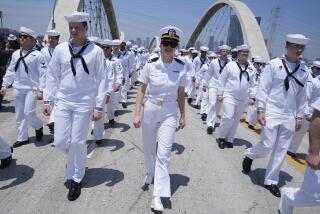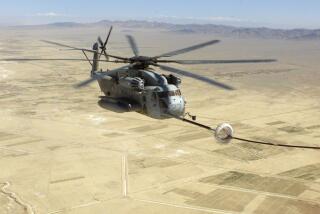Miramar Air Show gives public a look at military aircraft capabilities
- Share via
Reporting from SAN DIEGO — Keith Barton, who came from Ventura County to attend the opening ceremony of the Miramar Air Show, looked at the fighter jets and other military gear and was pleased.
“The world can be a very nasty place,” said Barton, 47, who runs a medical supply outfit. “It’s good to know we have this kind of capability.”
Peter Lee, 30, a Qualcomm employee from San Marcos, was among the many people bitterly disappointed when last year’s show was canceled due to the budget mess called sequestration. There was no way he was going to miss this year’s show.
“You can see the military’s capability in the media or on YouTube,” he said. “But this is up-close and personal.”
The air show, which began Friday and continues through Sunday at Marine Corps Air Station Miramar, is touted as the largest and most heavily attended military air show in the nation. Although the heat may slightly depress attendance, upward of 500,000 people are expected to attend.
Admission, parking and some grandstand seats are free. Seats beneath VIP-style tents come at a cost. For $85, for example, you can sit at a table in the shade, enjoying water, soda and a box lunch.
The Blue Angels, the Navy’s aerial demonstration team, are the headliners of the three-day event. Comprised of Navy and Marine Corps pilots, the Blue Angels fly F/A-18 Hornets, the same kind of aircraft assigned to the U.S. mission to bomb Islamic militant targets in Iraq and Syria.
“You can’t go over to Afghanistan or Iraq and see what we’re doing,” said Cmdr. Tom Frosch, the Blue Angels flight leader and squadron commander. “But you can come here and see much the same thing.”
The air show is proof anew, as if further proof were needed, that the military’s presence is the defining feature of the San Diego region, what distinguishes it from the rest of Southern California.
San Diego-area sailors and Marines were central to the wars in Afghanistan and Iraq. The same appears to be true in the evolving U.S. mission against the Islamic State.
On Tuesday, the U.S. Central Command announced that 2,300 Marines from Camp Pendleton, Miramar and Twentynine Palms are deploying to the Middle East as a “crisis response” unit, and will most likely be headquartered in Kuwait. (Planning for such a unit was underway before the Islamic State threat arose, the military said.)
On Wednesday, the Navy announced that a rescue mission was underway for a Marine who bailed out into the northern Persian Gulf from an MV-22 Osprey (the same kind of aircraft will be taking part in the air show).
The Marine was assigned to the Camp Pendleton-based amphibious assault ship Makin Island, which is in the gulf to support the air campaign in Iraq and Syria, the Navy said. Some 4,000 Marines and sailors are on the three ships of the Makin Island Amphibious Ready Group.
By Friday, the Marine was declared “lost at sea” and identified as Cpl. Jordan Spears, 21, from the Miramar-based Third Marine Aircraft Wing. Media reports labeled him the first fatality of the latest U.S. combat mission.
Also on Friday, the Navy confirmed that the Coronado-based carrier Carl Vinson will soon replace the carrier George H.W. Bush to continue airstrikes against Islamic State targets. Aboard the Vinson are 67 aircraft, 44 of which are capable of continuing airstrikes, the Navy said.
With its row of food stands selling corndogs, gyros, frozen margaritas, sweet roasted corn, nachos and more, plus other stands selling T-shirts, books and trinkets, much of the air show has the feel of a county fair or monster-truck arena. But that appearance is misleading, many spectators say.
Ardath DeRose, 60, a retired San Diego County employee living in Santee, attends the annual air show regularly, not only for the entertainment value but to refresh her contact with larger matters. On opening day, DeRose and her husband were in one of the tents awaiting the Blue Angels’ performance.
“It’s healthy for regular people to become more connected with our military,” she said. “We’re in a war and there is a seriousness here.”
More to Read
Sign up for Essential California
The most important California stories and recommendations in your inbox every morning.
You may occasionally receive promotional content from the Los Angeles Times.













